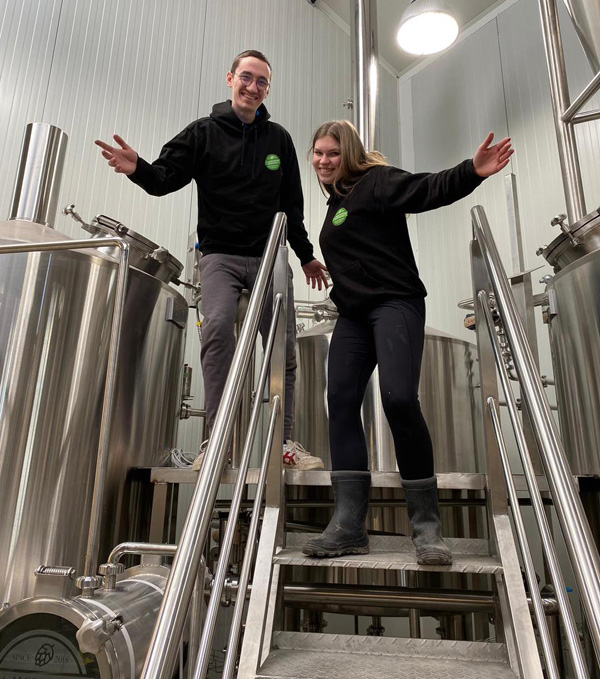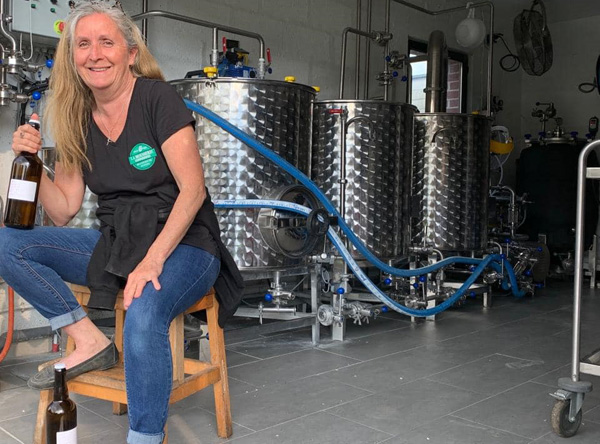Brewing a good batch of beer takes a lot of work – especially when being done for the masses.
Breweries require kettles, kegs, boilers, bottling and canning lines, conveyors, cooling systems, storage tanks, fermentation tanks, filters and beer-labeling machines as well as piping and tubing, refrigeration equipment, cleaning equipment, waste treatment systems, and tap handles for their operations.
Whether you’re starting from scratch and learning how to make beer for the first time, or moving your home-brewing masterpiece to a new craft brewery, opening a brewhouse of your own means that you’re going to need a lot of help.

Luckily, you’re not the only beer enthusiast out there, and there are thousands of brands and pieces of equipment to choose to include in your brewing process.
While not all brewery equipment may be necessary, there are key pieces of equipment that are considered must-haves in your brewery business plan in order to create a smooth process that produces great tasting beer every time.
Here are a few essential components that you will need. These are just the steps you need to take to get started, not the complete listing. There is also a lauter tun, electric stream generator, malt mill machine, wort pump, plat heat exchanger in a mash system. Yeast is fermented in a fermentation tank and other fermented components are added by yeast addition equipment and a cooling pump.
● Brewhouse
● Grain miller
● Water treatment machine
● Fermentation tank
● Bright tank
● Steam boiler
● Filtration system
● Heat exchanger
● Wort pump
● Glycol Cooling System
● CIP Cleaning System
● PID Semi-auto Control System
● Packaging equipment
● You may also need some brewery equipment accessories
Below we will list a variety of brewery equipment. These pieces of equipment are very important to start your own brewery.
The brewhouse is a container used for the mashing step in the brewing process. Brewhouse contains a mashing tank, lauter tank, kettle, whirlpool tank. Brewhouse has a variety of combinations. For example, 2 vessels, 3 vessels, 4 vessels. The Brewhouse is an insulated, temperature-controlled container. It can mix and heat starch and water. This is to convert the starch in the grain into sugar. Our Brewhouse is mirror-polished so that no bacteria will grow, and it can achieve 360° no dead angle cleaning.
What is mashing? Mashing is the act of mixing and heating grains and water used in beer. This is to break down the starch in the grain into sugar, which is eventually converted into alcohol in beer.
China’s high-end beer equipment manufacturer Micet Craft has developed Brewhouses with different capacities and different combinations. The price range of 1bbl-50bbl is 6000-100000 US dollars. This price is just a reference, please consult the engineers of Micet Craft for the specific price.

The first step in the brewing process is to grind the grains. Grain miller is used to grinding grains to ease preparation for the following steps. Milled grains are very important for brewing. Because finer grains can improve mashing efficiency. Of course, you can also extract more sugar from the wort during the fermentation process.
If the grain is crushed too finely, it is possible that the mashing will agglomerate and stick to the mashing tank in the later steps. In turn, it may affect the efficiency of later steps.
Water is the main ingredient of beer, and the quality of water directly affects the taste and feel of the beer. If you have low water requirements, you can use city drinking water directly. But, if you want to brew a variety of flavors of beer, it is recommended to use a water treatment machine. Also to meeting the standards of domestic water, the brewing water must also adjust the corresponding pH according to the beer style. The taste of beer brewed with different water will be different.
Fermentation is one of the most important processes in brewing beer. This is because yeast converts the sugar in the malt into alcohol and CO2. The beer fermentation tank is a container for the conversion of wort to alcohol. It allows your beer to ferment at a controlled temperature. We recommend that you use a conical fermentation tank. In this way, the yeast can be easily captured and taken out. This is because yeast can be reused. For the establishment of a brewery, the fermentation tank is one of the most important pieces of equipment. You need to choose a suitable fermentation tank based on the daily output.
The price of a fermentation tank varies according to its capacity. Of course, the need for a jacket will also affect the price of the fermenter. The jacketed fermenter is convenient for temperature control. The price range of 1bbl-30bbl is 2000-8000 USD. Please note that you may need many fermentation tanks for fermentation.
After fermentation is complete, the beer needs to be transferred to a bright tank. This is to further mature the beer and make the beer clear. Of course, you can also add carbonate to the can to carbonate the beer. The beer in the bright jar is ready to drink.
The price of the Bright tank is the same as the price of the fermentation tank, which varies according to the size of the capacity. The price range of 1bbl-30bbl is 1300-8000 USD.
The Steam boiler powers the heating of the brewhouse. Of course, you can also choose direct flame heating.
The filtration step in brewing is to extract solids (such as live yeast) from the liquid and prepare it for filling. Although live yeast is edible. But because yeast is sensitive to temperature changes, it may change the taste of beer. So, the yeast must be stored in a place where the temperature can be easily controlled. The use of filtration technology to remove yeast and debris can ensure that the taste of the beer will not change easily.
There are many types of filtration technology equipment on the market, which one you choose depends on your idea. The more popular filtering equipment is plate filters and candle filters.
Plate filters are the cheapest option for filtration. A plate filter is made up of vertical cloth-covered plates with hollow frames at a 90-degree angle. Beer is fed into the frames and solids are trapped by the cloth while the liquid goes through the filters and into tubes clean of any yeast.
Candle filters are another option that larger breweries prefer. A candle filter uses hollow, circular tubes with small openings in a cylindrical-shaped container. Then put the mixture of beer and diatomaceous earth into the container. In this container, the filter cleans the beer by trapping solids.
The choice of filtration equipment depends on the size and budget of the brewery. Remember, both of these filtering devices can solve the problem!
The heat exchanger can help raise or lower the temperature of the wort. This is very important when producing craft beer. A common form of heat exchanger uses many plates. Hot liquid flowing on one side heats the wort to make it boil. The other side introduces cold liquid to cool the wort to prepare for fermentation.
The use of heat exchangers can increase efficiency and save more wort. Of course, you can also increase the production of each batch of beer. Also, the heat exchanger reduces the amount of energy and emissions used. If you use a quality system, you can reduce the amount of water used in the entire brewing process.
The wort pump can help the “beer” be transported from one container to another sanitarily. For example, transfer beer from the fermentation tank to the Bright tank.
Beer tanks have cooling jackets. They are double-walled stainless-steel, insulated, and have large sections for the circulation of coolant-propylene glycol. A glycol chiller has a large reservoir as well as a refrigeration compressor. It keeps the glycol at 28-30° F. Glycol chilling keeps the beer stable and inhibits bacteria growth.
You will need a portable CIP (clean-in-pace) tank. It that you can use for housing your sanitation solution, caustic (alkaline cleaner for organics) wash, and acid washes (for mineral build-up). It may have a built-in circulation pump or can be paired with a portable pump.
You can use the vessels themselves as reservoirs, but the portable CIP tank streamlines the process.
With the CIP and pumps, you will sanitize all your production equipment as well as sanitize the other empty tanks. So that you can run many processes simultaneously: racking, filtering, wort production.
Without the right sanitation equipment and applicable chemicals. you should not even consider getting started with brewing a new batch of beer on-site.
Depending on how automated the brewery is, you may also have a centralized control panel for the brewery. The main control panel is optional. The controller can also be seen as a safety measure, which can be used to stop production and prevent accidents in the facility.
After the beer is brewed, the beer needs to be packaged. This helps maintain beer taste and cleanliness during transportation. The use of different packaging methods requires the use of different filling equipment. The use of kegs for packaging will must a keg filling machine and possibly a keg washing machine. The use of a can to package beer requires a can filling machine. If you use beer bottle filling, also to a bottle filling machine, you may also need a beer bottle labeling machine.
● Brewhouse Pipework
● Yeast Adding Tank
● Oxygenate Device
● Hydrometer
● Wort Thermometer
● Grain Rake
● Wort Hoses
● Steam Condenser

You now know all the essential brewery equipment for opening a brewhouse of your own and can start planning, budgeting, shopping, and – soon enough – brewing your own beer to share with the world.
We can’t wait to see what you brew up!
If you still don’t know where to buy this device, you can contact us. ZYBREW can provide you with a turnkey solution. looking forward to your cooperation!